people often ask what makes my home feel calm? Creating a calming space at home starts with understanding the elements that influence how a room makes you feel. It’s not just about pretty decoration it’s about the emotional response your surroundings create. A calm room is one that feels safe, grounded, and inviting. It helps you breathe a little easier, relax more deeply, and feel more centered.
but you may ask how can I create a calming space at home?
Soft, Neutral Colors: One of the biggest contributors to a peaceful environment is color. Calming spaces often feature soft, muted tones like beige, ivory, sage green, soft blues, or warm greys. These shades tend to reduce mental stimulation and evoke feelings of peace and stillness.
Natural Light: A room bathed in sunlight can instantly boost your mood and energy while still feeling relaxing. Natural light helps regulate your body’s circadian rhythm, which affects sleep and stress levels. If natural light is limited, opt for soft, warm-toned lighting that mimics daylight.
Minimal Clutter: Clutter creates visual noise. A calming space feels open and organized, not crowded or chaotic. By decluttering and embracing simplicity, your room becomes more functional and mentally freeing. Think “less is more.”
Soft Textures & Comforting Materials: Plush throws, soft rugs, cotton sheets, linen curtains these tactile elements make a space feel cozy and welcoming. Layering different textures can add interest without visual overwhelm.
Personal Touches: A calming space should still feel like you. Framed photos, favorite books, a scent you love, or even a small plant can bring a sense of comfort and familiarity.
Sound & Smell: Background noise and scent also influence how calm a space feels. Consider soft music, nature sounds, or even silence. Aromatherapy think lavender, eucalyptus, or sandalwood can soothe your senses and reinforce that serene atmosphere. A calm room isn’t just aesthetically pleasing it engages your senses in a gentle, intentional way. In the next section, we’ll explore how to set the tone for calmness before even thinking about decoration
Start with Intentional Decluttering
Before you buy a single throw pillow or light a calming candle, take a good look around your space. Clutter is one of the biggest enemies of peace. It creates stress, distracts the eye, and can make even the most beautifully styled room feel chaotic. That’s why the first real step in creating a calming space is to declutter with intention.
Why Decluttering Matters
Decluttering isn’t just about cleaning; it’s about clearing space for your mind to rest. Visual clutter often translates to mental clutter. When every surface is packed, when drawers are overflowing, and closets are bursting, your brain stays in overdrive even at home. By reducing unnecessary items, you make room for what truly brings you joy and comfort.
Decluttering with Intention
Rather than rushing through and tossing things at random, take a mindful approach. Start small one drawer, one shelf, or one corner at a time. Ask yourself:
Do I use this regularly?
Does it bring me peace or joy?
Is this item adding calm or chaos to my space?
If something doesn’t serve a purpose or spark a sense of calm, consider donating, recycling, or storing it out of sight.
Clear Surfaces = Clear Mind
Focus on clearing flat surfaces like countertops, nightstands, desks, and dressers. These areas tend to attract clutter quickly, but they also play a huge role in how “light” or “heavy” a room feels. Keep only a few carefully chosen items on display—perhaps a scented candle, a favorite book, or a small plant.
Storage is Your Friend
Creating calm doesn’t mean throwing everything away. It means being thoughtful about what’s visible. Use baskets, bins, trays, and decorative boxes to organize the things you need to keep but don’t want out in the open. Storage solutions can be both functional and beautiful, adding to the aesthetic while keeping mess tucked away.
A Routine That Supports Calm
Finally, remember that maintaining a decluttered space is just as important as starting one. Consider setting a weekly habit of resetting your space. Put things back where they belong, do a quick surface sweep, and let your environment breathe again.
When your space is clear, your mind follows. Now that the canvas is clean, let’s move on to how you can use color and light to shape the atmosphere of your calming space.
Choose Soothing Colors and Natural Light
One of the most effective ways to create a calming space at home is through thoughtful use of color and lighting. These two elements work hand-in-hand to influence the atmosphere of a room and, in turn, your emotional well-being. The right shades and lighting choices can make your space feel peaceful, grounded, and welcoming.
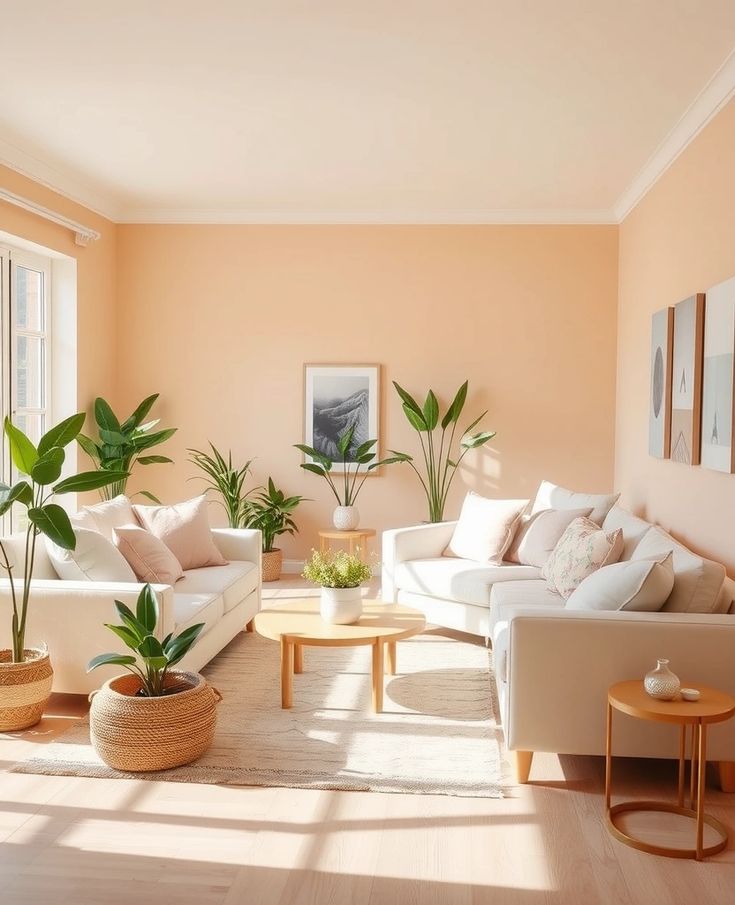
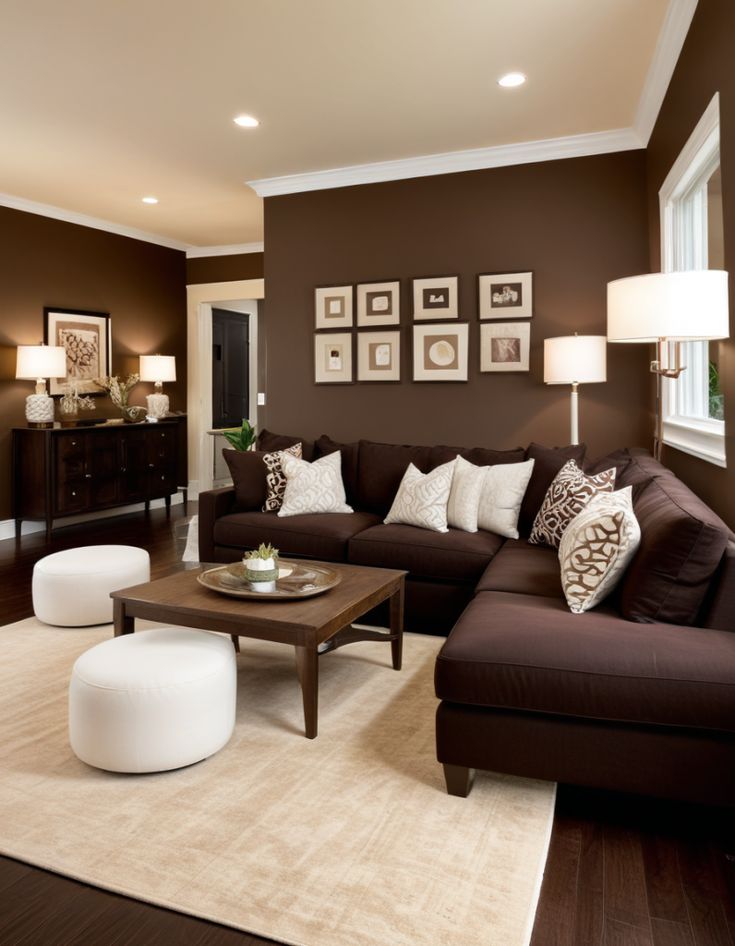
photo credit:https://www.pinterest.com/pin/895090494741810705/
The Psychology of Color in Calm Spaces
Color plays a powerful role in how we feel in a room. Some colors energize us, while others bring a sense of stillness. For a calming effect, stick with soft, muted tones that evoke nature and serenity.
Popular calming color palettes include:
Soft Neutrals – Ivory, beige, taupe, and warm whites create a grounded, clean base.
Earth Tones – Sage green, terracotta, clay, and sand connect us with nature and bring warmth.
Cool Hues – Pale blues, gentle greys, and lavender are soothing and can visually “cool down” a room.
Dusty Pinks and Mauves – These soft shades add femininity and warmth without overstimulating the senses.
Avoid overly bold or bright colors like neon or primary reds in areas meant for rest. These can be great in creative zones, but in a calming space, they often feel loud.
What Makes a Room Feel Calm?
People often wonder what makes a room feel truly calm. While many factors come into play, color and light are at the top of the list. A calm room usually has a limited, cohesive color palette, balanced lighting, and very few jarring elements. Soft contrasts, rather than sharp ones, help keep the eye moving gently across the room without interruption.
Maximize Natural Light
Light has a direct impact on your mood. Natural light is uplifting and helps regulate your body’s circadian rhythm, improving sleep and emotional balance. Here’s how to make the most of it:
Keep windows unobstructed. Use sheer curtains or blinds that let in plenty of daylight.
Position mirrors strategically. They reflect light and visually expand the space.
Choose reflective, light-colored finishes. These bounce natural light around the room, making it feel brighter and airier.
If you’re not a plant person yet, start with one or two and place them where you spend the most time. Even faux plants, when chosen thoughtfully, can still visually mimic the calm of nature.

Use Natural Materials in Decoration
Wood, cotton, linen, bamboo, rattan, clay, and stone all help create a tactile, grounded feel. They connect us to the outdoors and lend warmth and texture to any room.
Ways to bring in natural materials:
Wooden furniture or trays
Woven baskets for storage
Linen curtains or cotton throws
Terracotta or ceramic vases
Rattan accent chairs or lighting fixtures
Natural textures encourage you to slow down and feel present in your environment—key elements of a calming atmosphere.
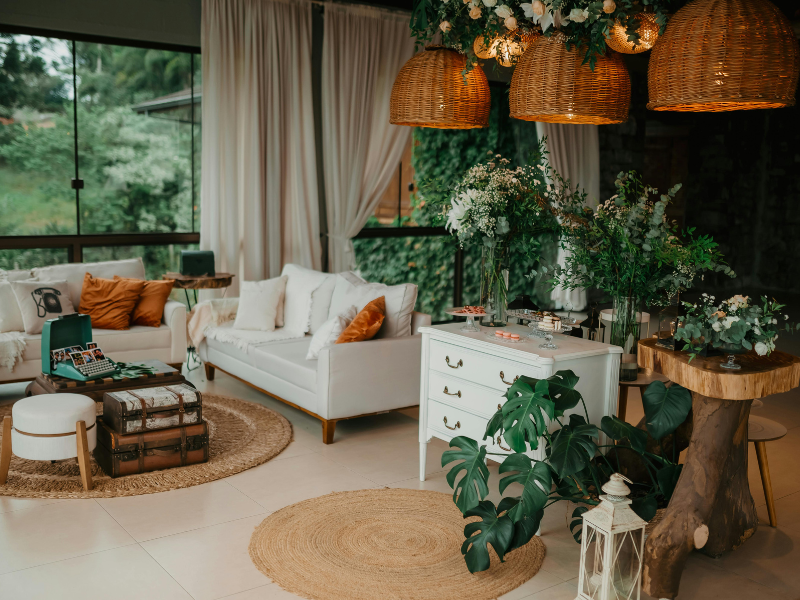
Scents from Nature: Aromatherapy for the Soul
Scent plays a subtle but powerful role in shaping how we feel. Incorporating calming scents through natural diffusers, essential oils, or even fresh flowers can significantly enhance your environment.
Relaxing scents to try:
Lavender – Known for its stress-relieving properties
Eucalyptus – Refreshing and great for mental clarity
Chamomile – Calming and great before bedtime
Sandalwood or Cedar – Grounding and coz Whether you prefer candles, incense, or oil diffusers, adding fragrance to your home can help mark the transition between stress and stillness.
Water Features and Natural Sounds
If you really want to take it up a notch, adding a small tabletop fountain or playing nature sounds (like ocean waves or rustling leaves) can mimic the soothing effects of being outdoors.
This completes your foundation of a nature-infused, calming atmosphere.
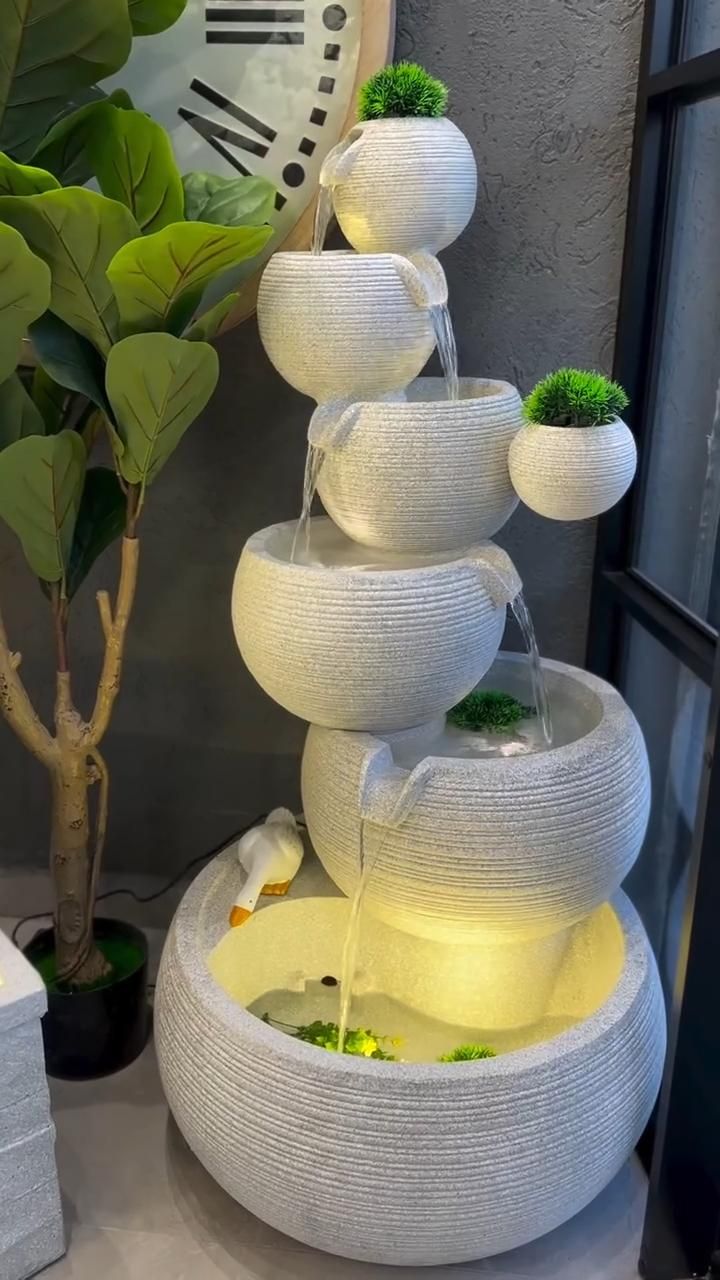
photo credit:https://www.pinterest.com/pin/122441683614498778/
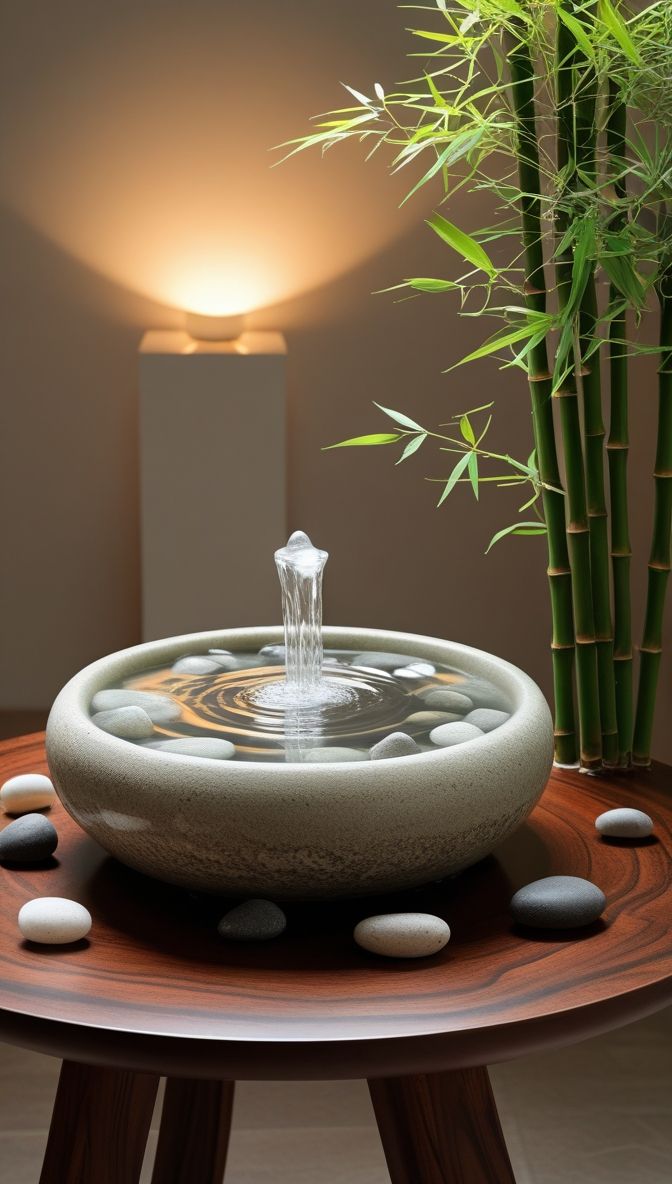
photo credit:https://www.pinterest.com/pin/122441683614498778/
Declutter and Simplify Your Space
You can’t truly relax in a space that feels chaotic. Clutter not only overwhelms your home it overwhelms your mind. That’s why creating a calming space starts with clearing the unnecessary and making room for what truly supports your peace and well-being.
Why Decluttering Matters for Mental Clarity
A cluttered room can lead to a cluttered mind. When your environment feels out of control, it’s harder to focus, think clearly, or feel calm. On the other hand, a tidy, intentional space helps reduce stress and brings a sense of order and calm.
Research has shown that people who live in cluttered environments are more likely to experience fatigue, anxiety, and even disrupted sleep. Simplifying your space can instantly make it feel lighter, fresher, and more soothing.
Start Small and Be Intentional
Decluttering doesn’t mean going full minimalist overnight. The goal is to remove what no longer serves you and make space for what uplifts you.
Here’s a step-by-step approach to simplify your space:
Choose one area at a time – A drawer, a shelf, or a corner. Don’t try to tackle the whole room at once.
Ask the right questions – “Do I use this regularly?” “Does this make me feel good?” “Is it adding peace or clutter?”
Sort items into 3 categories – Keep, Donate, Let Go.
Organize what remains – Use storage boxes or baskets to contain loose items and maintain order.
Let Go of Guilt Clutter
We all keep things out of guilt gifts we don’t love, clothes we never wear, or decoration that doesn’t match our vibe. Remember, your home should reflect who you are now, not who you were or who others expect you to be.
Letting go of items you’ve outgrown can be empowering. It’s an act of self-respect to choose peace over pressure.
Create “Clear Zones” in Each Room
Even if you love a cozy, lived-in space, having one clutter-free area in each room like a clean nightstand, an empty kitchen counter, or a tidy coffee table gives your mind a visual break. It helps you breathe easier and focus better.
Use the One-Minute Rule
If a task takes less than one minute (putting away shoes, folding a blanket, wiping down a surface), do it right away. This habit prevents small messes from snowballing into stress-inducing clutter.
Decluttering is one of the most powerful (and free) ways to transform your home into a space that supports calm and clarity. When you’re ready, we’ll dive into.
Lighting and Color: Setting the Mood
Lighting and color are two of the most powerful tools when it comes to shaping how a room feels. They can influence your mood, energy levels, and even your sense of comfort. If you want to create a calming space at home, you need to be intentional about both.
The Role of Lighting in Creating Calm
Lighting sets the tone literally. Harsh, bright lights can feel clinical and energizing, which is great for task-oriented spaces but not ideal when you’re trying to relax. On the other hand, warm, soft lighting promotes a sense of calm and comfort.
Here’s how to use lighting for a more peaceful environment:
Use layered lighting – Combine overhead lights, table lamps, floor lamps, and candles to create depth and warmth.
Swap harsh white bulbs for soft, warm-toned ones – Look for bulbs labeled “warm white” or with a color temperature around 2700K–3000K.
Add dimmers – They let you adjust the light to your mood and time of day.
Use string lights or fairy lights – These add a gentle glow and a cozy feel without overwhelming the space.
Let in natural light – Open the curtains or blinds during the day. Sunlight lifts the mood and makes any space feel fresher and more alive.
Calming Colors: What Makes a Room Feel Calm?
Your color choices can either stimulate or soothe. For a calming space, steer away from bold, overly bright colors and opt for hues that evoke serenity and balance.
Top calming colors include:
Soft neutrals – Like beige, ivory, taupe, and greige (a mix of gray and beige).
Earthy tones – Warm browns, sage greens, terracotta, and sand tones bring in grounding energy.
Cool blues and muted greens – These shades are scientifically known to lower stress and promote a sense of peace.
Lavender or dusty pinks – Light pastels can bring a soft, gentle femininity to a space.
Color Tip: Paint isn’t your only tool. Use throw pillows, blankets, artwork, and rugs to introduce calming tones without committing to full-scale changes.
Balance Is Key
You don’t have to paint your whole house white or remove every bright color. Instead, aim for balance. Use soothing tones as your base, then layer in pops of color through accessories and personal touches.
Remember, the goal is to create a space that feels calm to you. If a soft blush or ocean blue brings you joy and peace, that’s your color.
Perfect! Let’s move on.
Personal Touches That Soothe the Soul
Creating a calming space isn’t just about how your home looks it’s also about how it feels to you. While minimalist design and soothing colors help set the foundation, it’s the personal, meaningful touches that truly turn a house (or a room) into your sanctuary.
This is where your heart comes in. Think about the things, objects, and memories that bring you comfort, joy, or inspiration—and find ways to incorporate them into your surroundings.
Meaningful Decoration Makes a Difference
One of the best ways to add warmth and soul to a space is through items that carry personal meaning:
Photographs of loved ones or moments you cherish. Frame them in simple, elegant frames and place them on a nightstand, wall, or shelf.
Artwork that makes you feel peaceful or inspired whether it’s a print, a painting, or something you created yourself.
Travel souvenirs that remind you of your favorite destinations. A seashell from the beach, a handmade bowl from a local market these can become calming visual anchors.
When decorating with intention, ask yourself: Does this item make me feel good when I see it? If the answer is yes, it belongs in your space.
Scent: The Invisible Mood Booster
Scent has a powerful link to emotion and memory. Adding a signature scent to your space can instantly lift your mood and help you relax.
Use essential oil diffusers with calming blends like lavender, chamomile, eucalyptus, or sandalwood.
Try scented candles made with natural ingredients (soy or beeswax) for a warm glow and soft fragrance.
Incorporate linen sprays or incense for short bursts of calming aroma.
Choose scents that comfort or center you. And don’t underestimate how much scent can help you associate your space with rest and renewal.

photo credit:https://www.pinterest.com/pin/889320257674956695/
Soothing Textures & Natural Elements
Engage your sense of touch with cozy, calming textures:
Bring in nature with houseplants, wooden accents, stones, or natural fibers like jute and cotton.
These tactile details offer comfort, while natural elements connect you back to earth both mentally and visually.
read more:https://luxeandleanblog.com/2025/07/15/daily-habits-for-a-luxurious-lifestyle/
Create a Signature Ritual
Think about a small daily routine you can enjoy in your calming space:
Morning journaling with a cup of tea.
A quiet evening skincare routine with soft lighting and calming music.
A 10-minute breathing exercise with essential oils before bed.
By adding intentional rituals, your space becomes more than just pretty it becomes therapeutic.
Your Calm, Your Way
Creating a calming space at home isn’t about following rigid design rules or achieving a picture-perfect aesthetic. It’s about building an environment that truly supports your peace, recharges your energy, and reflects who you are. Whether you’re transforming a small bedroom corner or revamping your entire living room, the key is to approach it with mindfulness and intention.
We’ve explored how calming colors, natural light, soft textures, and a bit of nature can instantly change the atmosphere of your space. We’ve also talked about minimizing clutter, personalizing with meaningful items, and even incorporating rituals and scents that speak directly to your senses. All of these things work together to create a space that feels like home not just in function, but in soul.
Remember, calm looks different for everyone. For one person, it’s clean lines and warm neutrals; for another, it’s layered boho textures and soft lighting. You don’t have to overhaul your entire home at once start small. Replace your harsh lighting with something softer. Declutter a surface. Add one new cozy throw or a houseplant. It all counts.
And more importantly, give yourself permission to change things as your needs evolve. A calming space is meant to grow with you. You may want a quiet nook for journaling today and a more energizing corner for creating tomorrow. That’s the beauty of curating a home that truly supports your well-being, it adapts.
Leave a Reply